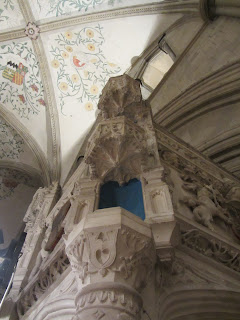I managed to get along to Boxgrove Priory on Sunday, where the chantry chapel set up by Thomas West, “eighth Baron West and ninth Baron de la Warr” (1472–1554) is the big feature. It’s dated to 1532, and de la Warr intended it as a final resting place for himself and his wife, with a chantry priest to say masses for their souls in purgatory.
So far, so perfectly late-Medieval Catholic. History and
Henry VIII overtook this project: Boxgrove was abruptly dissolved as a priory. Thomas
West tried in vain to get it exempted, then settled pragmatically for retaining
the main priory building as a parish church. But even then, the long-lived de
la Warr was never to be buried in the beautiful personal shrine he'd had erected. Accused of playing a part in a
conspiracy, he had to swap his local manor house, to which the king had taken a
fancy, for a former nunnery at Whewell in Hampshire. That was the price of his
pardon for an invented crime. Leaving Sussex, he left this chapel behind him, though I imagine he wondered about having it taken apart and transported.
It had been a daring piece of work just getting the chantry
in the church and close to the altar: a whole pier was removed, with the double
size arch above it strengthened – even so, load bearing vaults no longer sweep down to approach the absent column, but splay
across almost horizontally. Everything hovers above this miracle of faith, and has
done so without trouble for nearly 500 years.
What a piece of work it is, eloquent of so much. The
decoration mixes the heraldry of the de la Warre family, Tudor roses, and
faith. It its original state, viewers must have seen a structure that ascended
up from a joyous motifs of the fleshly world – fat cherubs play lutes, two
young men swarm up one column, throwing down fruit to a girl who holds out her
apron. Hercules fights the Nemean lion, a King and Death stand either side of a
tree, dragons writhe.
Then above this, the divine realm: the riotously decorated
columns, turn into their structural negatives, niches for with saints topped with intricate
Gothic canopies. Heaven is held up by faith, not stone. Sinuous movement turns to
fixity, the contemplation of God - music might come from heaven without visible
performers, certainly not from fat-legged cherubs. All the saints disappeared,
of course: the empty niches conjure them up, spectacular victims of all that
jostling life down below them, martyred again in effigy. I imagine their
battered torsos will be in a pit somewhere close at hand, maybe dug down to the
paleo-surface where Boxgrove man and his fellows slaughtered extinct animals half a million years before.
Decorative motifs for the carvings were apparently taken
from a French Book of Hours. The lively realm of classical
motifs, images from fabliau and moral tale, and stiff Tudor roses seem to be
pushing the Gothic world higher towards heaven. Though to an extent, the elaborate coats of arms and Orders of
the Garter aspire towards joining the building’s divine realm:
angels obligingly display dynastic honours.
The intricate vaulting within makes it seem as if the masons
could extrude stone through an icing nozzle or fresh pasta maker. As decorative
as a gypsy caravan, the chantry stayed where it was and journeyed forwards
through time.
Sir Thomas Wyatt could have gone down to Chichester and seen
this structure when it was new. Anne Boleyn was about to become queen. Of its
time in its jollity, its Tudor patriotism, all of the certainties of its
theology were about to be stripped away. The double sized arch held up: the
metaphorical roof fell in.





No comments:
Post a Comment